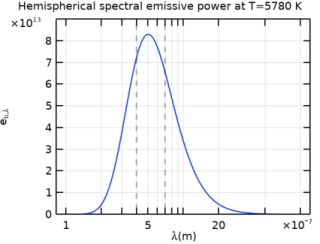
|
•
|
|
•
|
h is the Planck constant (SI unit: J·s)
|
|
•
|
kB is the Boltzmann constant (SI unit: J/K)
|
|
•
|
c0 is the speed of the light in vacuum (SI unit: m/s)
|
|
•
|
λ is the wavelength in vacuum (SI unit: m)
|
|
•
|
n is the refractive index of the media (SI unit: 1), equal to 1 in vacuum
|

|
The function eb(T) is available as a predefined function via rad.feb(T) in the Surface-to-Surface Radiation interface.
|

|
Continuous and piecewise constant predefined functions are available, as well as a predefined plot, in the Surface-to-Surface Radiation interface to display the wavelength dependency of material properties in the manner of the figure above. See Predefined Functions for the Surface-to-Surface Radiation Interface for details.
|